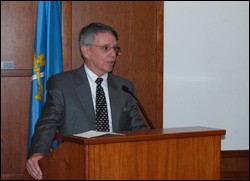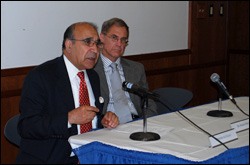JINSA Leaders Participate in 2009 Middle East Security Workshop at the National Defense University
 Members of JINSA’s Board of Directors participated in a daylong workshop on June 1, 2009 at the National Defense University at Ft. McNair in Washington, DC. The Middle East Security Workshop was sponsored by the Near East South Asia (NESA) Center for Strategic Studies, and featured panel discussions on regional security challenges in the Middle East; U.S.
Members of JINSA’s Board of Directors participated in a daylong workshop on June 1, 2009 at the National Defense University at Ft. McNair in Washington, DC. The Middle East Security Workshop was sponsored by the Near East South Asia (NESA) Center for Strategic Studies, and featured panel discussions on regional security challenges in the Middle East; U.S.
 Members of JINSA’s Board of Directors participated in a daylong workshop on June 1, 2009 at the National Defense University at Ft. McNair in Washington, DC. The Middle East Security Workshop was sponsored by the Near East South Asia (NESA) Center for Strategic Studies, and featured panel discussions on regional security challenges in the Middle East; U.S. National Security Strategy; Afghanistan and South Asia; the rise of Russia and China; and the continuing evolution and adaptation of global terrorist groups. More than 50 members of the JINSA leadership from around the country attended the program.
Members of JINSA’s Board of Directors participated in a daylong workshop on June 1, 2009 at the National Defense University at Ft. McNair in Washington, DC. The Middle East Security Workshop was sponsored by the Near East South Asia (NESA) Center for Strategic Studies, and featured panel discussions on regional security challenges in the Middle East; U.S. National Security Strategy; Afghanistan and South Asia; the rise of Russia and China; and the continuing evolution and adaptation of global terrorist groups. More than 50 members of the JINSA leadership from around the country attended the program.
The NESA Center for Strategic Studies is the preeminent U.S. Government institution for building relationships and understanding in the NESA region. The Center fosters open communication and educational opportunities for military and civilian representatives from the NESA region and other participating countries. The academic environment facilitates a cross-cultural examination of the events, ideas, and challenges shaping the critical region. In keeping with NESA’s strict non-attribution policies, meant to foster open and free dialogue, none of the speakers will be identified by name.

Regional Issues
Regional security issues dominated the day. On Iraq, it was posited that the surge of troops under the previous administration produced mixed results. On the positive side, there has been tremendous improvement in the security situation along with the turnover of responsibility to Iraqi forces in most of the provinces. On the other hand, however, sectarian interests still dominate both at the local and national levels, and the Iraqi government is unable to provide services efficiently and without corruption. The presenter concluded that the continuing U.S. presence allows Iraqis to put off making the hard decisions, and the outcome is still uncertain.
Recognizing the concerns of America’s Gulf allies over Iranian bellicosity, the administration has proposed new military aid packages for those countries.  Some Gulf nations fear that a sectarian regime in Iraq would pave the way for Iranian influence there.
Some Gulf nations fear that a sectarian regime in Iraq would pave the way for Iranian influence there.
Afghanistan and Pakistan also remain priorities for President Obama, where he plans to send 21,000 new troops into Afghanistan in the coming year. Providing additional resources to the State Department for the stabilization and humanitarian assistance required in both countries will be a challenge for the administration as well. Changing the thinking of the Pakistani military from the possibility of set-piece battles with India to counter-terrorism and counter-insurgency against the Taliban appears to be the key problem for securing Pakistan. Afghanistan was called a “weak state but a strong nation,” alluding to the difficulties of building government institutions that can deliver services and control territory. Afghans, however, see themselves as part of the nation of Afghanistan and there are no separatist movements. The Taliban is seen by only a single-digit minority as an alternative to the current government.
Plans to make the Israel-Palestinian “peace process” a priority in the region focused on a “two state solution” that includes an independent Palestinian state alongside Israel.  There is a clear focus on strengthening the hand of the Palestinians by providing “confidence building” measures, including a halt to Israeli building activity in the West Bank. Although the core issues still remain – defined as Jerusalem, settlements, refugees, water, air and sea space rights, without mention of terrorism, incitement or the legitimacy of Israel – some parts of the Bush Road Map will be used by the Obama Administration as benchmarks for Israeli and Palestinian responsibilities.
There is a clear focus on strengthening the hand of the Palestinians by providing “confidence building” measures, including a halt to Israeli building activity in the West Bank. Although the core issues still remain – defined as Jerusalem, settlements, refugees, water, air and sea space rights, without mention of terrorism, incitement or the legitimacy of Israel – some parts of the Bush Road Map will be used by the Obama Administration as benchmarks for Israeli and Palestinian responsibilities.
“Old” versus “new” terrorist groups, and terrorist groups as “learning organizations” was another theme. Successful terrorist groups, some more than 20 years old, continually adapt to the changing international environment. Hamas (founded in 1988), Hezbollah (1982), Colombia’s FARC (1964) and the Taliban (1988) have all become more technologically sophisticated and have adapted to local politics. Terror groups can now reach ever larger segments of the population including through online publishing, Internet chat rooms and transmitting over thousands of FM radio stations. The ability of these groups to control the first spin on either their own activities or counter-terrorism operations is extremely important for these groups.
The Taliban in Afghanistan has also become more effective at communication, which is due mostly to al Qaeda assistance. Technologically backward themselves, the Taliban have allowed al-Qaeda to take over their “communications,” reaching quickly into the right-wing religious press in both Afghanistan and Pakistan, which can be easily manipulated to reach a wider audience.
to take over their “communications,” reaching quickly into the right-wing religious press in both Afghanistan and Pakistan, which can be easily manipulated to reach a wider audience.
All of these sophisticated terrorist organizations have studied their adversaries very effectively, and adapted and adjusted their narrative and their activities accordingly. They have latched onto local conditions and are able to subvert and undermine unstable governments, including in Pakistan and Afghanistan. They support local groups by providing training and equipment, and inculcate them into their vision of global jihad.
Although the United States has not suffered additional large-scale acts of terrorism since 9-11, recruitment has taken place in the United States including the recruitment of young Somali men who were sent to Africa for training and used as terrorists there.
Russia and China
In a joint presentation, panelists put Russian and Chinese political, military and economic aspirations into historical perspective. The Chinese view of leadership, the drive to retain it and China’s historical view of itself as an important country in the world – coupled with the essential search for natural resources and the continuing effects of the Chinese Civil War (as the Cultural Revolution was called) – are the impetus for its current policies. While conflict with the United States was a possible outcome of those drives, conflict is not inevitable. Russia, on the other hand, is in the midst of one of its periodic boom and bust economic cycles, driving its relations with the West as well as the countries of the former Soviet Union.
for natural resources and the continuing effects of the Chinese Civil War (as the Cultural Revolution was called) – are the impetus for its current policies. While conflict with the United States was a possible outcome of those drives, conflict is not inevitable. Russia, on the other hand, is in the midst of one of its periodic boom and bust economic cycles, driving its relations with the West as well as the countries of the former Soviet Union.
Both countries are concerned about the possibility of an Iranian nuclear weapons capability, but each – for different reasons – is unlikely to take concerted action with the United States and its allies to prevent it. China has an interest in Iranian energy and a concern for the spread of Islamic radicalism to Western China. Russia is more concerned about Sunni radicalism, such as it faced in Chechnya.
The presenters indicated that the Obama Administration was in a good position to address Russian and Chinese concerns; neither discussed the likelihood that American concerns with Russian or Chinese policies would be addressed.
Quadrennial Defense Review (QDR)
The program was rounded out by a presentation on the building of the Quadrennial Defense Review, the Defense Department’s statement of strategy and resource requirements for the military.